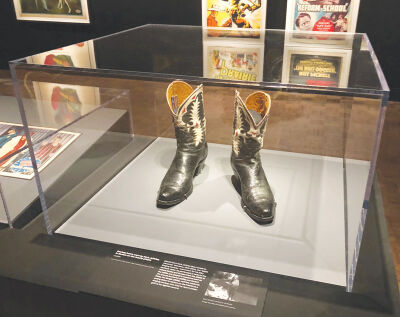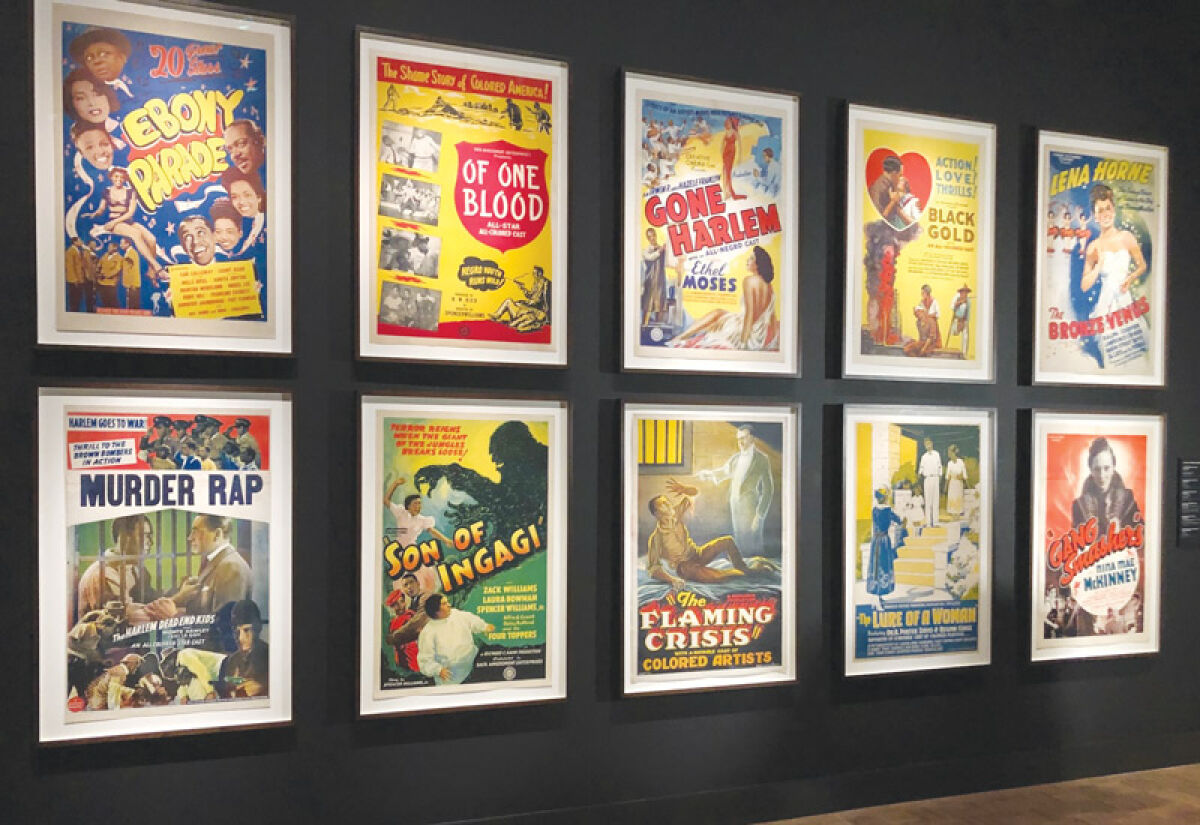
The cowboy boots worn by Detroit-born actor Herb Jeffries in the 1937 film “Harlem on the Prairie” are one of the artifacts on display in “Regeneration.” Jeffries, who made his acting debut in this movie, was known as the “Sepia Singing Cowboy” for his baritone singing voice.
Photo by K. Michelle Moran
DETROIT — A largely lost but pivotal part of the history of American cinema is being brought to life by a new exhibition at the Detroit Institute of Arts.
“Regeneration: Black Cinema 1898-1971” looks at the films, filmmakers, actors and studios from this period. Originally organized by the Academy Museum of Motion Pictures, the exhibition runs Feb. 4 through June 23. The Detroit Film Theatre at the DIA, which celebrates its 50th anniversary this year, is showing a companion film series that will enable audiences to see some of the movies referenced in the exhibition.
“We are honored to present ‘Regeneration,’ a powerful, inspiring and important exhibition that examines the rich and often untold history of Blacks in American cinema,” DIA Director Salvador Salort-Pons said in a press release. “The exhibition explores the critical roles played by pioneering Black actors, filmmakers, and advocates to shape and influence U.S. cinema and culture in the face of enduring racism and discrimination.”
Rhea L. Combs, director of curatorial affairs for the Smithsonian National Portrait Gallery, was one of the co-curators of this exhibition. She said there was a “parallel history” between the better-known general history of filmmaking and that of Black cinema.
Between 1915 and 1948, more than 150 independent production companies across the United States — including the Maurice Film Co. in Detroit — made what were called “race films,” or films starring Black actors made for Black audiences, at a time when moviegoing was highly segregated. These movies ran the gamut from comedies to Westerns to melodrama.
“I think it’s really about a sense of empowerment and pride and possibility,” Combs said. “There has been a longstanding, rich tradition of African American involvement in cinema since the beginning. … We want to make sure we’re expanding the understanding that this is not a separate cinema — it was working alongside American mainstream cinema.”
More than half of the films made before 1950 no longer exist and the majority of the race films were lost, said Elliot Wilhelm, curator of film for the DIA. Besides chemical decomposition and the fact that the silver nitrate film stock of the time was notoriously unstable, Wilhelm said early film studios believed that once people had seen a movie, they wouldn’t want to see it again — this was long before the era of streaming, cable or even network television. So, Wilhelm said, studios would routinely melt down movie negatives or positives to make new films. And while Hollywood films were usually stored in climate-controlled facilities, the same wasn’t true for those made by the independents, Wilhelm said.
But then there are the exciting discoveries of films thought to be lost, like 1939’s “Reform School,” a film about prison reform that starred Lewis Beavers as a probation officer. A screening of “Reform School” took place Feb. 4 at the DFT.
“During our research, we were able to find it in the archives and have it restored,” said co-curator Doris Berger, vice president of curatorial affairs at the Academy Museum of Motion Pictures.
The exhibition opens with “Something Good — Negro Kiss,” an 1898 short film that contains the earliest known cinematic depiction of Black intimacy. Combs said this film “serves as a counterbalance” to stereotypical depictions of Black individuals in Hollywood films.
“It was important for us to bring this moment of celebration and joy forward,” Combs said.
The exhibition features almost 200 historical objects — including photographs, posters, costumes, script pages and magazine covers — as well as relevant contemporary artworks, home movies, newsreels and more. Visitors will also see how Black actors like Harry Belafonte and Ruby Dee played an important role in civil rights advocacy.
“Regeneration” was about five years in the making, Berger said.
“Part of our mission (at the Academy Museum) was and still is exploring undervalued topics; this was fitting to our mission,” Berger said.
She said the show was a big success in Los Angeles, so they were happy to be able to bring it to additional audiences in Detroit.
Berger said the exhibition demonstrates agency, resiliency and creativity on the part of the Black filmmaking community, along with “the power of what could have been and should have been” during the decades covered in the exhibition.
Wilhelm is thrilled the “Regeneration” series is coinciding with the DFT’s 50th anniversary year.
“This is a story we (as a museum) wanted to be a part of. … This narrative, this story told by the exhibition needs to be told,” Wilhelm said. “What we want to do is tell (visitors) about this missing part of American cinema and African American history. … I believe cinema is extremely important because it’s a storytelling medium that’s seen by a huge number of people.”
Admission to “Regeneration” is free with regular museum admission, which means it’s free for residents of Wayne, Oakland and Macomb counties, said DIA Marketing Director Jessica Carreras. She said admission to the films in the “Regeneration” series is free to everyone.
 Publication select ▼
Publication select ▼






















